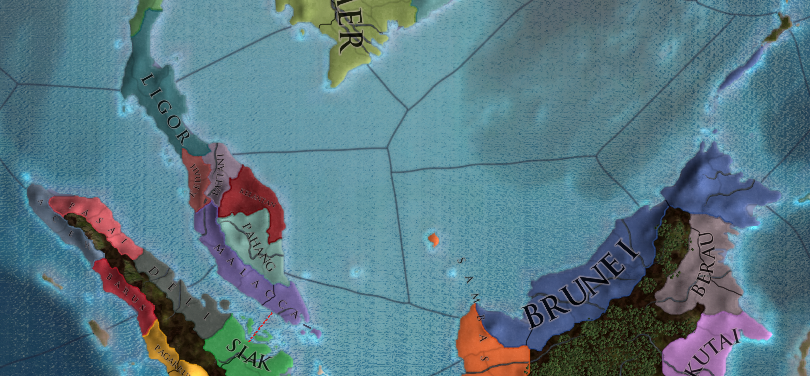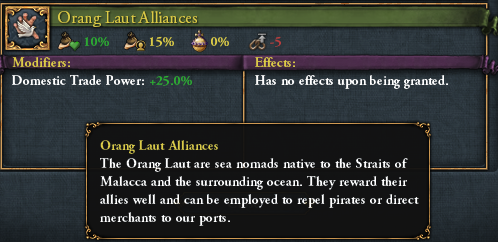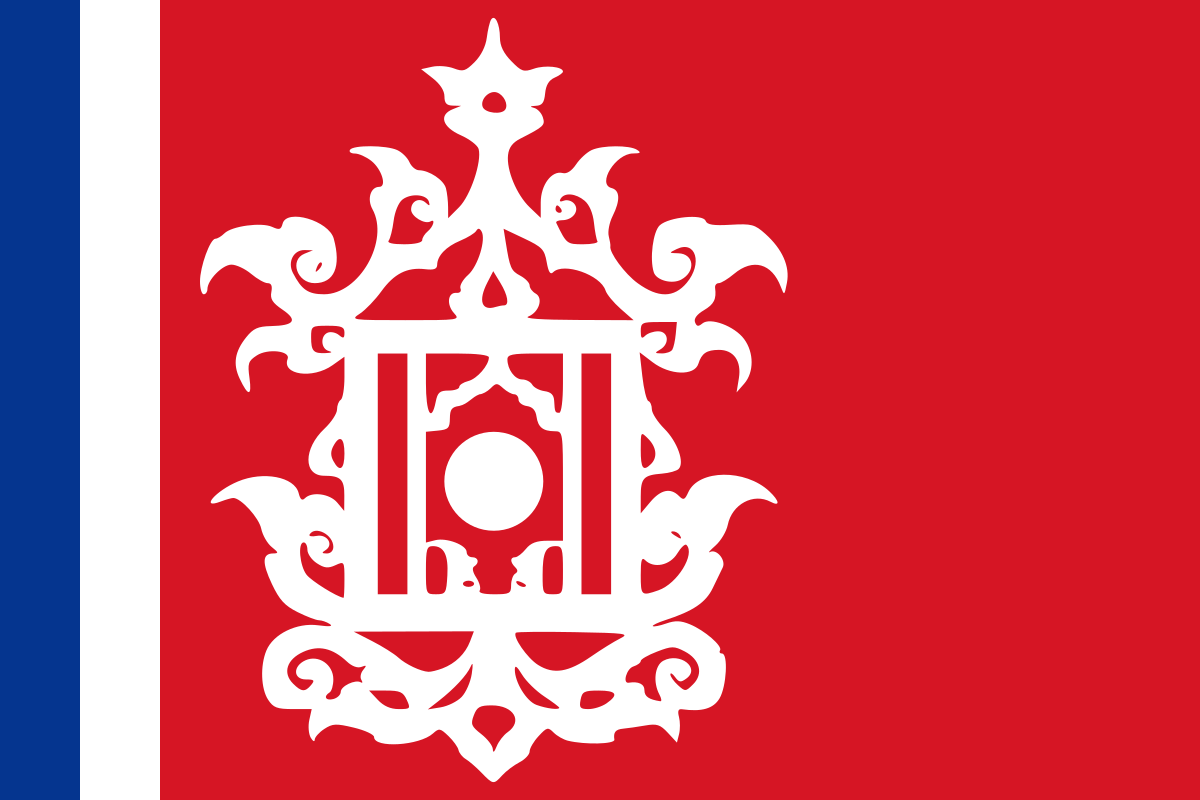Good morning! In today’s dev diary we’ll be taking a look at three nations in Maritime South-East Asia: the Sultanates of Brunei, Malacca, and Aceh. Each of these nations founded successful empires during our period, and each has a unique set of national ideas and missions.


Mission trees for Malay nations other than Majapahit are split into 4 sections. In red are missions unique to that country, in this case Malacca. In green and blue are missions available to all Malay nations, and in purple are missions available only after forming Malaya.
The Malacca Sultanate is a descendent of the Srivijaya Kingdom which dominated Java, Sumatra, and the Malay Peninsula prior to the rise of Majapahit. Malacca won the favor of Ming China during the period of Zheng He’s voyages, which set the rising city-state up to be a serious contender to Majapahit’s hegemony. By 1444 Malacca is the richest city-state in the Malay world due to its maritime control over the straits. Malacca would go on expand further on the Malay Peninsula and even onto Sumatra, before ultimately succumbing to Portuguese invasion in 1511.
Malaccan missions reflect their expansion path and diplomatic ties. Some highlights:
Malaccan national ideas allow them to truly dominate the spice trade and get the most out of their vassals.

The Aceh Sultanate wouldn’t reach its apex until the reign of Iskandar Muda in 1583, but it’s available to play from 1444. Aceh’s missions and national ideas are also available to neighboring Pasai, which was richer and more dominant in our start date. Iskandar Muda’s conquests would gain Aceh an empire spanning most of the Sumatran coast as well as parts of the Malay Peninsula. Perhaps the most important contribution of the Aceh region to history is its status as the Porch of Mecca, the most prominent hub of Islam in Maritime SEA.
Aceh’s mission tree follows their historical conquests of Sumatra and the Malay Peninsula, but more interestingly it also encourages the player to spread Islam across the region. Some highlights:
Acehnese national ideas reflect the focus on trade, navy-driven conquest, and religious conversion:

Brunei is a renegade Sultanate, breaking away from Majapahit rule while also avoiding an uncomfortably close relationship with Ming China. The Bruneian Empire would grow to encompass the entire coast of Borneo as well as parts of the Philippines, and was able to resist repeated attempts at European domination long after many of its peers had fallen.
Brunei’s missions lead them to unite Borneo under their rule, and also on a campaign of conquest in the Philippines. The missions Impress Manilla and Impress Sulu vassalize those nations if you can maintain good relations with them, regardless of whether they’d normally accept vassalization. Many of Brunei’s missions also add a province modifier to uncolonized provinces that make them much faster to colonize, hastening their unification of the islands.
Brunei’s national ideas emphasize their dominant navy and diplomatic prowess:

One last thing for today - last week I showed off some new Estate Privileges, but there is one I didn’t show that is exclusive to countries with their capital in the Malaya region. The Orang Laut were (and still are) groups of maritime nomads who extensively engaged in trade with the Malay kingdoms. They were often employed to divert trade to certain ports and to deter pirates, and would grant their allies lands and titles on the islands within their domain. This is in fact how the Malacca Sultanate got its start - Seri Teri Buana, a Srivijayan prince, was granted the small Kingdom of Singapura (modern Singapore) by the Orang Laut, a polity which would eventually become the Malacca Sultanate. Malacca begins with the Orang Laut Alliances estate privilege.
And that’s all for this week! Next week’s dev diary will be a focus on Vietnam, including the new mission trees for Dai Viet and Champa.


Mission trees for Malay nations other than Majapahit are split into 4 sections. In red are missions unique to that country, in this case Malacca. In green and blue are missions available to all Malay nations, and in purple are missions available only after forming Malaya.
The Malacca Sultanate is a descendent of the Srivijaya Kingdom which dominated Java, Sumatra, and the Malay Peninsula prior to the rise of Majapahit. Malacca won the favor of Ming China during the period of Zheng He’s voyages, which set the rising city-state up to be a serious contender to Majapahit’s hegemony. By 1444 Malacca is the richest city-state in the Malay world due to its maritime control over the straits. Malacca would go on expand further on the Malay Peninsula and even onto Sumatra, before ultimately succumbing to Portuguese invasion in 1511.
Malaccan missions reflect their expansion path and diplomatic ties. Some highlights:
- Wherever appropriate, Subjugation CB’s are awarded instead of permanent claims
- If you complete the Subjugate Pahang mission by vassalizing Pahang, they will get a ruler of your dynasty, reduced liberty desire, and their religion will be changed from Mahayana to your religion.
- Malacca is no longer a Ming tributary in 1444. Though in theory they maintained their relations, in reality Ming had largely abandoned its interests in the region. The Emissary to the Emperor mission allows you to restore your special relationship with Ming China.
- Befriend Champa ties in with one of Champa’s missions - Champa needs to make a Sunni friend in Maritime SEA which gives them the option to convert to Sunni. Completing this mission grants a Subjugation CB against Champa’s greatest enemy: Dai Viet.
- The mission Make a Show of Force requires having a superior army to both Majaphit and Siak. By demonstrating your superiority over their old overlords, Siak will willingly become your vassal.
- The Develop Malacca mission can upgrade Malacca’s Center of Trade to level 3 after you improve its development and construct buildings in the province - including a Fort to repel the pesky Portuguese.
- Loyal subjects grants -10 Liberty Desire in all your subjects until the end of the game.
- Destroy Majapahit, as you might imagine, requires Majapahit to entirely cease to exist as well as for Malacca to gain a foothold on Java. Completing this mission awards a version of Majapahit’s unlimited subjugation CB: the Malacca Campaigns CB can be used against any country in the Malay culture group and the warscore cost for vassalization is reduced by 25%.
Malaccan national ideas allow them to truly dominate the spice trade and get the most out of their vassals.
Code:
MLC_ideas = {
start = {
global_trade_power = 0.1
naval_forcelimit_modifier = 0.33
}
bonus = {
merchants = 1
}
trigger = {
tag = MLC
}
free = yes
mlc_vassal_princes = {
reduced_liberty_desire = 10
vassal_income = 0.25
}
mlc_maritime_laws = {
global_ship_trade_power = 0.2
}
mlc_new_hegemony = {
diplomatic_reputation = 1
}
mlc_islamic_sultanate = {
tolerance_own = 1
}
mlc_habor_masters = {
trade_steering = 0.2
num_accepted_cultures = 1
}
mlc_daulat = {
legitimacy = 1
}
mlc_jawi_script = {
idea_cost = -0.1
}
}
The Aceh Sultanate wouldn’t reach its apex until the reign of Iskandar Muda in 1583, but it’s available to play from 1444. Aceh’s missions and national ideas are also available to neighboring Pasai, which was richer and more dominant in our start date. Iskandar Muda’s conquests would gain Aceh an empire spanning most of the Sumatran coast as well as parts of the Malay Peninsula. Perhaps the most important contribution of the Aceh region to history is its status as the Porch of Mecca, the most prominent hub of Islam in Maritime SEA.
Aceh’s mission tree follows their historical conquests of Sumatra and the Malay Peninsula, but more interestingly it also encourages the player to spread Islam across the region. Some highlights:
- Completing the Porch of Mecca mission allows you to use the Propagate religion trade policy with only 35% trade power in a node (down from 50%), and also unlocks the Sword of Islam CB, which allows the Force Religion peace treaty against nations with Sumatran primary culture. This CB evolves as you continue to spread your faith across the islands, gaining the ability to target Javanese, Sundanese, Moluccan, and Sulawesi cultures. Completing this branch of the mission tree allows you to use the Sword of Islam CB against any neighboring heathen country.
- Hindus and Buddhists in the Malay culture group now have a decision to convert to Sunni Islam if it becomes their dominant religion. This gives Aceh the option to spread their faith through peaceful trade or by military force; the choice is yours.
Acehnese national ideas reflect the focus on trade, navy-driven conquest, and religious conversion:
Code:
ATJ_ideas = {
start = {
global_ship_cost = -0.1
global_missionary_strength = 0.02
}
bonus = {
production_efficiency = 0.1
}
trigger = {
OR = {
tag = PSA
tag = ATJ
}
}
free = yes
export_economy = {
global_trade_power = 0.1
}
islamise_sumatra = {
missionary_maintenance_cost = -0.25
}
rise_of_aceh = {
province_warscore_cost = -0.1
}
military_adventures = {
naval_morale = 0.15
}
porch_of_mecca = {
technology_cost = -0.10
}
acehnese_moneylending = {
interest = -1
}
settle_the_islands = { # same as malay ideas
global_colonial_growth = 20
}
}
Brunei is a renegade Sultanate, breaking away from Majapahit rule while also avoiding an uncomfortably close relationship with Ming China. The Bruneian Empire would grow to encompass the entire coast of Borneo as well as parts of the Philippines, and was able to resist repeated attempts at European domination long after many of its peers had fallen.
Brunei’s missions lead them to unite Borneo under their rule, and also on a campaign of conquest in the Philippines. The missions Impress Manilla and Impress Sulu vassalize those nations if you can maintain good relations with them, regardless of whether they’d normally accept vassalization. Many of Brunei’s missions also add a province modifier to uncolonized provinces that make them much faster to colonize, hastening their unification of the islands.
Brunei’s national ideas emphasize their dominant navy and diplomatic prowess:
Code:
BEI_ideas = {
start = {
land_morale = 0.1
global_ship_cost = -0.1
}
bonus = {
ship_durability = 0.1
}
trigger = {
tag = BEI
}
free = yes
bei_galleys = {
galley_power = 0.2
}
bei_sea_nomads = {
global_sailors_modifier = 0.2
}
bei_diplomacy = {
diplomatic_reputation = 1
}
bei_vassals = {
reduced_liberty_desire = 10
}
settle_the_islands = { # same as malay ideas
global_colonial_growth = 20
}
bei_naval_prowess = {
naval_morale = 0.15
}
bei_trade = {
trade_efficiency = 0.1
}
}
One last thing for today - last week I showed off some new Estate Privileges, but there is one I didn’t show that is exclusive to countries with their capital in the Malaya region. The Orang Laut were (and still are) groups of maritime nomads who extensively engaged in trade with the Malay kingdoms. They were often employed to divert trade to certain ports and to deter pirates, and would grant their allies lands and titles on the islands within their domain. This is in fact how the Malacca Sultanate got its start - Seri Teri Buana, a Srivijayan prince, was granted the small Kingdom of Singapura (modern Singapore) by the Orang Laut, a polity which would eventually become the Malacca Sultanate. Malacca begins with the Orang Laut Alliances estate privilege.
And that’s all for this week! Next week’s dev diary will be a focus on Vietnam, including the new mission trees for Dai Viet and Champa.








